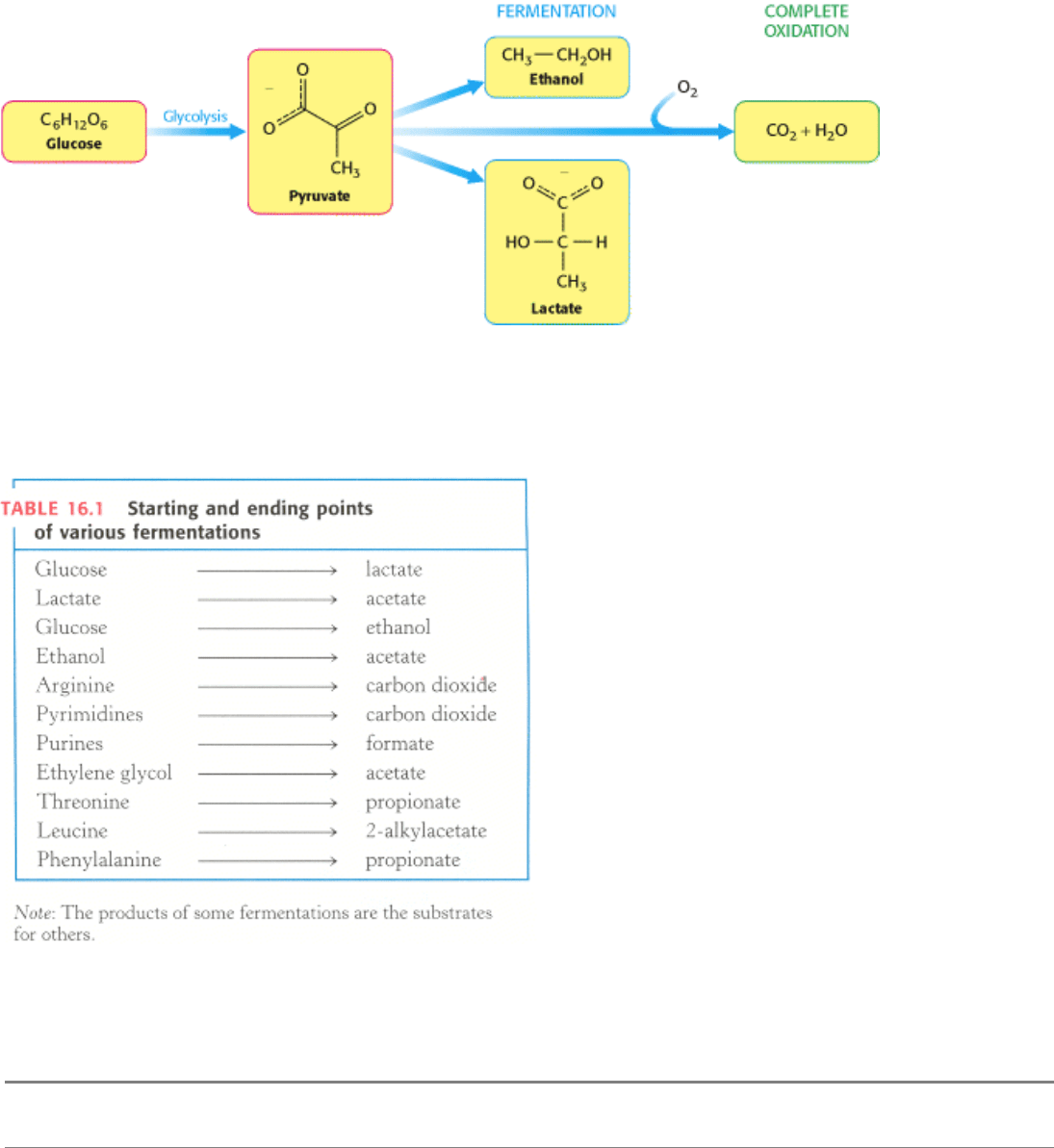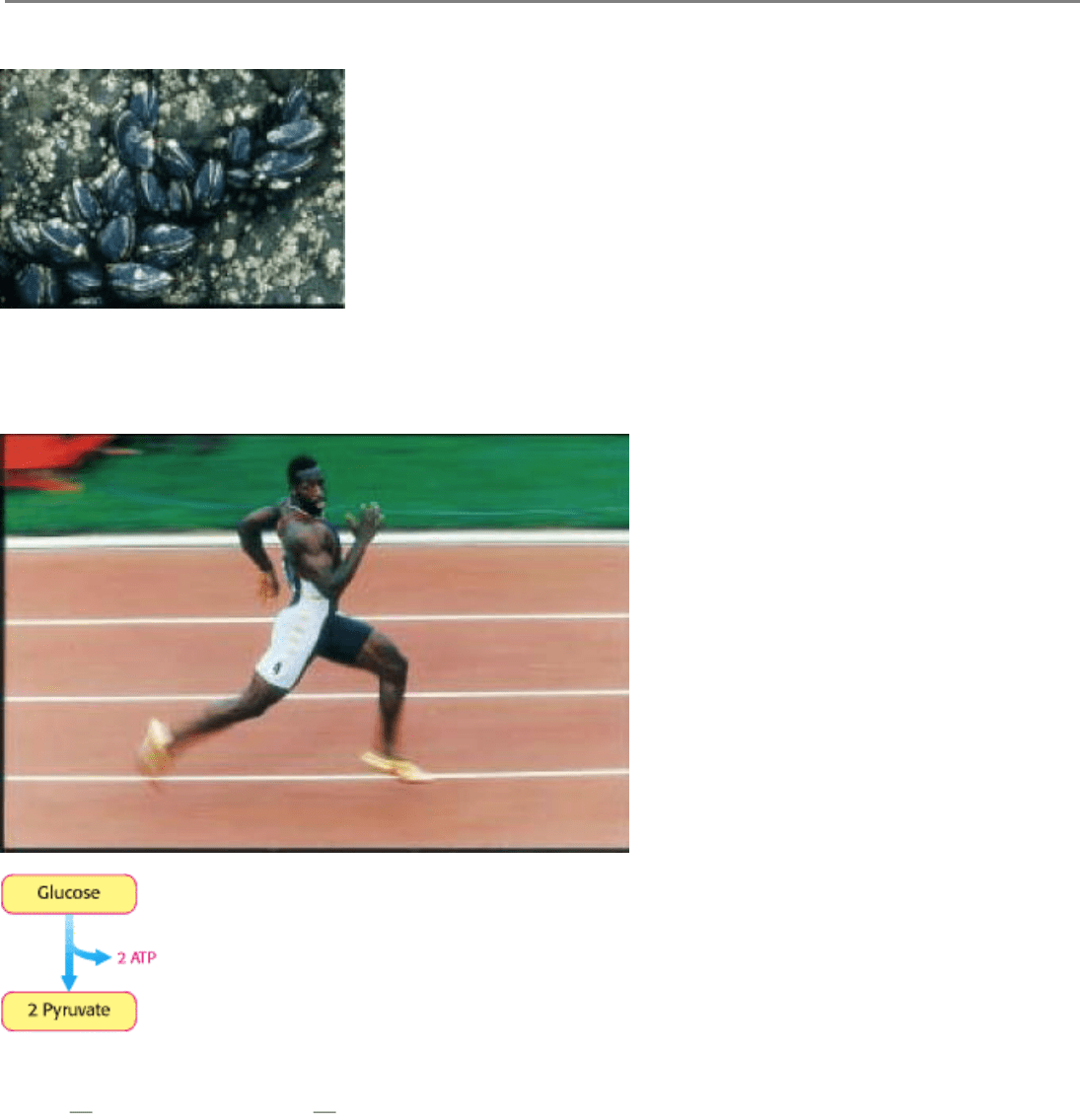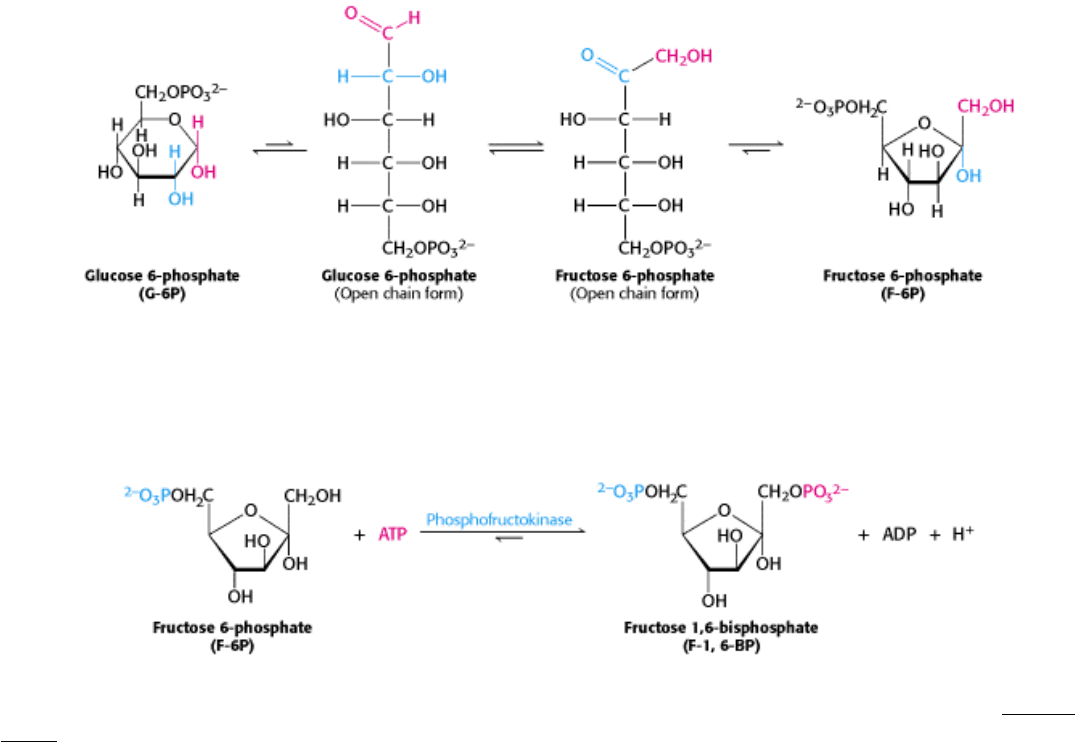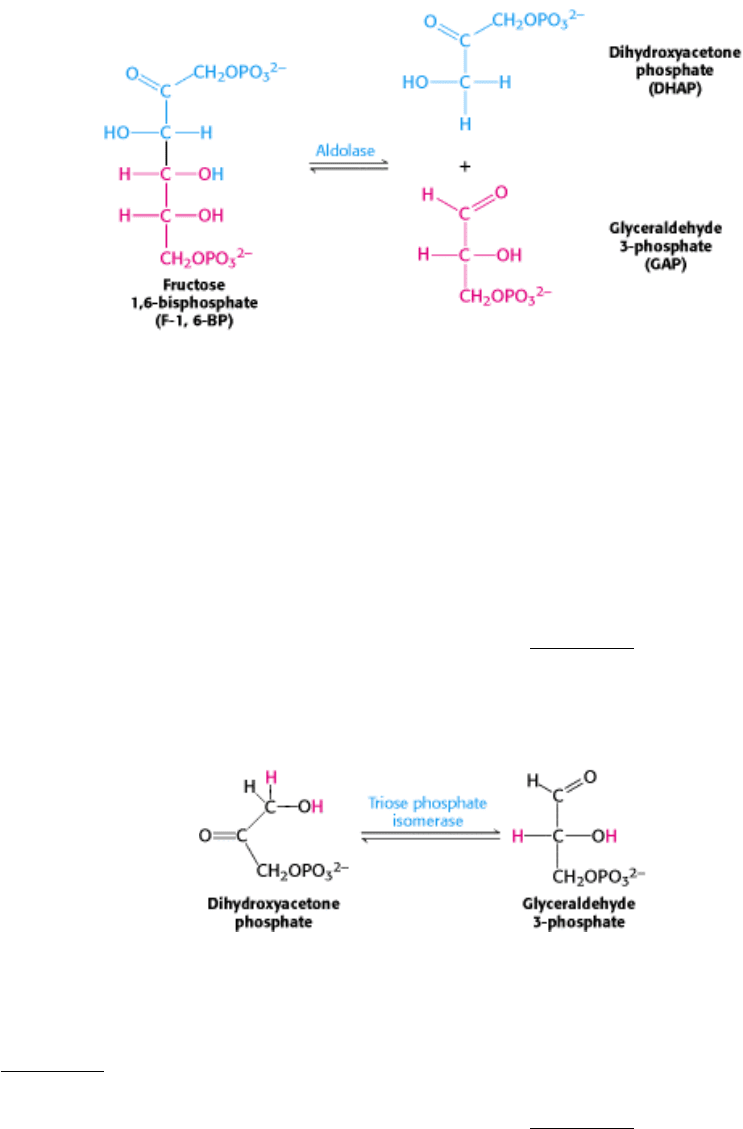Berg J.M., Tymoczko J.L., Stryer L. Biochemistry
Подождите немного. Документ загружается.


II. Transducing and Storing Energy 15. Signal-Transduction Pathways: An Introduction to Information Metabolism
Selected Readings
Where to start
J.D. Scott and T. Pawson. 2000. Cell communication: The inside story Sci. Am. 282: (6) 7279.
T. Pawson. 1995. Protein modules and signalling networks Nature 373: 573-580. (PubMed)
J.H. Hurley and J.A. Grobler. 1997. Protein kinase C and phospholipase C: Bilayer interactions and regulation Curr.
Opin. Struct. Biol. 7: 557-565. (PubMed)
T. Okada, O.P. Ernst, K. Palczewski, and K.P. Hofmann. 2001. Activation of rhodopsin: New insights from structural
and biochemical studies Trends Biochem. Sci. 26: 318-324. (PubMed)
R.Y. Tsien. 1992. Intracellular signal transduction in four dimensions: From molecular design to physiology Am. J.
Physiol. 263: C723-C728. (PubMed)
Loewenstein, W. R., 1999. Touchstone of Life : Molecular Information, Cell Communication, and the Foundations of
Life. Oxford University Press.
G proteins and 7TM receptors
K. Palczewski, T. Kumasaka, T. Hori, C.A. Behnke, H. Motoshima, B.A. Fox, I. Le Trong, D.C. Teller, T. Okada, R.E.
Stenkamp, M. Yamamoto, and M. Miyano. 2000. Crystal structure of rhodopsin: A G protein-coupled receptor Science
289: 739-745. (PubMed)
R.J. Lefkowitz. 2000. The superfamily of heptahelical receptors Nat. Cell Biol. 2: E133-E136. (PubMed)
H.R. Bourne, D.A. Sanders, and F. McCormick. 1991. The GTPase superfamily: Conserved structure and molecular
mechanism Nature 349: 117-127. (PubMed)
D.G. Lambright, J.P. Noel, H.E. Hamm, and P.B. Sigler. 1994. Structural determinants for activation of the alpha-
subunit of a heterotrimeric G protein Nature 369: 621-628. (PubMed)
J.P. Noel, H.E. Hamm, and P.B. Sigler. 1993. The 2.2 Å crystal structure of transducin-alpha complexed with GTP
gamma S. Nature 366: 654-663.
J. Sondek, D.G. Lambright, J.P. Noel, H.E. Hamm, and P.B. Sigler. 1994. GTPase mechanism of G proteins from the 1.7-
Å crystal structure of transducin alpha-GDP-AIF
4
-
Nature 372: 276-279. (PubMed)
J. Sondek, A. Bohm, D.G. Lambright, H.E. Hamm, and P.B. Sigler. 1996. Crystal structure of a G-protein beta gamma
dimer at 2.1 Å resolution Nature 379: 369-374. (PubMed)
P.B. Wedegaertner, P.T. Wilson, and H.R. Bourne. 1995. Lipid modifications of trimeric G proteins J. Biol. Chem. 270:
503-506. (PubMed)
Z. Farfel, H.R. Bourne, and T. Iiri. 1999. The expanding spectrum of G protein diseases N. Engl. J. Med. 340: 1012-
1020. (PubMed)
J. Bockaert and J.P. Pin. 1999. Molecular tinkering of G protein-coupled receptors: An evolutionary success EMBO J.
18: 1723-1729. (PubMed)
cAMP cascade
J.H. Hurley. 1998. The adenylyl and guanylyl cyclase superfamily Curr. Opin. Struct. Biol. 8: 770-777. (PubMed)

J.H. Hurley. 1999. Structure, mechanism, and regulation of mammalian adenylyl cyclase J. Biol. Chem. 274: 7599-7602.
(PubMed)
J.J. Tesmer, R.K. Sunahara, A.G. Gilman, and S.R. Sprang. 1997. Crystal structure of the catalytic domains of adenylyl
cyclase in a complex with G
s
α
GTPγS Science 278: 1907-1916. (PubMed)
C.M. Smith, E. Radzio-Andzelm, Madhusudan, P. Akamine, and S.S. Taylor. 1999. The catalytic subunit of cAMP-
dependent protein kinase: Prototype for an extended network of communication Prog. Biophys. Mol. Biol. 71: 313-341.
(PubMed)
S.S. Taylor, J.A. Buechler, and W. Yonemoto. 1990. cAMP-dependent protein kinase: Framework for a diverse family
of regulatory enzymes Annu. Rev. Biochem. 59: 971-1005. (PubMed)
Phosphoinositide cascade
M.J. Berridge and R.F. Irvine. 1989. Inositol phosphates and cell signalling Nature 341: 197-205. (PubMed)
M.J. Berridge. 1993. Inositol trisphosphate and calcium signalling Nature 361: 315-325. (PubMed)
L.O. Essen, O. Perisic, R. Cheung, M. Katan, and R.L. Williams. 1996. Crystal structure of a mammalian
phosphoinositide-specific phospholipase C δ Nature 380: 595-602. (PubMed)
K.M. Ferguson, M.A. Lemmon, J. Schlessinger, and P.B. Sigler. 1995. Structure of the high affinity complex of inositol
trisphosphate with a phospholipase C pleckstrin homology domain Cell 83: 1037-1046. (PubMed)
E. Baraldi, K.D. Carugo, M. Hyvonen, P.L. Surdo, A.M. Riley, B.V. Potter, R. O'Brien, J.E. Ladbury, and M. Saraste.
1999. Structure of the PH domain from Bruton's tyrosine kinase in complex with inositol 1,3,4,5-tetrakisphosphate
Structure Fold Des. 7: 449-460. (PubMed)
Calcium
M. Ikura, G.M. Clore, A.M. Gronenborn, G. Zhu, C.B. Klee, and A. Bax. 1992. Solution structure of a calmodulin-target
peptide complex by multidimensional NMR Science 256: 632-638. (PubMed)
H. Kuboniwa, N. Tjandra, S. Grzesiek, H. Ren, C.B. Klee, and A. Bax. 1995. Solution structure of calcium-free
calmodulin Nat. Struct. Biol. 2: 768-776. (PubMed)
G. Grynkiewicz, M. Poenie, and R.Y. Tsien. 1985. A new generation of Ca
2+
indicators with greatly improved
fluorescence properties J. Biol. Chem. 260: 3440-3450. (PubMed)
R. Kerr, V. Lev-Ram, G. Baird, P. Vincent, R.Y. Tsien, and W.R. Schafer. 2000. Optical imaging of calcium transients
in neurons and pharyngeal muscle of C. elegans Neuron 26: 583-594. (PubMed)
D. Chin and A.R. Means. 2000. Calmodulin: a prototypical calcium sensor Trends Cell Biol. 10: 322-328. (PubMed)
A.P. Dawson. 1997. Calcium signalling: How do IP3 receptors work? Curr. Biol. 7: R544-R547. (PubMed)
Protein kinases, including receptor tyrosine kinases
H. Riedel, T.J. Dull, A.M. Honegger, J. Schlessinger, and A. Ullrich. 1989. Cytoplasmic domains determine signal
specificity, cellular routing characteristics and influence ligand binding of epidermal growth factor and insulin receptors
EMBO J. 8: 2943-2954. (PubMed)
S.S. Taylor, D.R. Knighton, J. Zheng, J.M. Sowadski, C.S. Gibbs, and M.J. Zoller. 1993. A template for the protein
kinase family Trends Biochem. Sci. 18: 84-89. (PubMed)

F. Sicheri, I. Moarefi, and J. Kuriyan. 1997. Crystal structure of the Src family tyrosine kinase Hck Nature 385: 602-609.
(PubMed)
G. Waksman, S.E. Shoelson, N. Pant, D. Cowburn, and J. Kuriyan. 1993. Binding of a high affinity phosphotyrosyl
peptide to the Src SH2 domain: Crystal structures of the complexed and peptide-free forms Cell 72: 779-790. (PubMed)
J. Schlessinger. 2000. Cell signaling by receptor tyrosine kinases Cell 103: 211-225. (PubMed)
M.A. Simon. 2000. Receptor tyrosine kinases: Specific outcomes from general signals Cell 103: 13-15. (PubMed)
D.R. Robinson, Y.M. Wu, and S.F. Lin. 2000. The protein tyrosine kinase family of the human genome Oncogene 19:
5548-5557. (PubMed)
S.R. Hubbard. 1999. Structural analysis of receptor tyrosine kinases Prog. Biophys. Mol. Biol. 71: 343-358. (PubMed)
C. Carter-Su and L.S. Smit. 1998. Signaling via JAK tyrosine kinases: Growth hormone receptor as a model system
Recent Prog. Horm. Res. 53: 61-82. (PubMed)
Ras
M.V. Milburn, L. Tong, A.M. deVos, A. Brunger, Z. Yamaizumi, S. Nishimura, and S.H. Kim. 1990. Molecular switch
for signal transduction: Structural differences between active and inactive forms of protooncogenic Ras proteins Science
247: 939-945. (PubMed)
P.A. Boriack-Sjodin, S.M. Margarit, D. Bar-Sagi, and J. Kuriyan. 1998. The structural basis of the activation of Ras by
Sos Nature 394: 337-343. (PubMed)
S. Maignan, J.P. Guilloteau, N. Fromage, B. Arnoux, J. Becquart, and A. Ducruix. 1995. Crystal structure of the
mammalian Grb2 adaptor Science 268: 291-293. (PubMed)
Y. Takai, T. Sasaki, and T. Matozaki. 2001. Small GTP-binding proteins Physiol. Rev. 81: 153-208. (PubMed)
Cancer
B.J. Druker, C.L. Sawyers, H. Kantarjian, D.J. Resta, S.F. Reese, J.M. Ford, R. Capdeville, and M. Talpaz. 2001.
Activity of a specific inhibitor of the BCR-ABL tyrosine kinase in the blast crisis of chronic myeloid leukemia and acute
lymphoblastic leukemia with the Philadelphia chromosome N. Engl. J. Med. 344: 1038-1042. (PubMed)
B. Vogelstein and K.W. Kinzler. 1993. The multistep nature of cancer Trends Genet. 9: 138-141. (PubMed)
C.A. Ellis and G. Clark. 2000. The importance of being K-Ras Cell. Signal. 12: 425-434. (PubMed)
D. Hanahan and R.A. Weinberg. 2000. The hallmarks of cancer Cell 100: 57-70. (PubMed)
F. McCormick. 1999. Signalling networks that cause cancer Trends Cell Biol. 9: M53-M56. (PubMed)

II. Transducing and Storing Energy
16. Glycolysis and Gluconeogenesis
The first metabolic pathway that we encounter is glycolysis, an ancient pathway employed by a host of organisms.
Glycolysis is the sequence of reactions that metabolizes one molecule of glucose to two molecules of pyruvate with the
concomitant net production of two molecules of ATP. This process is anaerobic (i.e., it does not require O
2
) inasmuch as
it evolved before the accumulation of substantial amounts of oxygen in the atmosphere. Pyruvate can be further
processed anaerobically (fermented) to lactate (lactic acid fermentation) or ethanol (alcoholic fermentation). Under
aerobic conditions, pyruvate can be completely oxidized to CO
2
, generating much more ATP, as will be discussed in
Chapters 17 and 18.
Glucose can be synthesized from noncarbohydrate precursors, such as pyruvate and lactic acid, in the process of
gluconeogenesis. Although glycolysis and gluconeogenesis have some of the same enzymes in common, the two
pathways are not simply the reverse of each other. In particular, the highly exergonic, irreversible steps of glycolysis are
bypassed in gluconeogenesis. Both pathways are stringently controlled by intercellular and intracellular signals, and they
are reciprocally regulated so that glycolysis and gluconeogenesis do not take place simultaneously in the same cell to a
significant extent.
Our understanding of glucose metabolism, especially glycolysis, has a rich history. Indeed, the development of
biochemistry and the delineation of glycolysis went hand in hand. A key discovery was made by Hans Buchner and
Eduard Buchner in 1897, quite by accident. The Buchners were interested in manufacturing cell-free extracts of yeast for
possible therapeutic use. These extracts had to be preserved without the use of antiseptics such as phenol, and so they
decided to try sucrose, a commonly used preservative in kitchen chemistry. They obtained a startling result: sucrose was
rapidly fermented into alcohol by the yeast juice. The significance of this finding was immense. The Buchners
demonstrated for the first time that fermentation could take place outside living cells. The accepted view of their day,
asserted by Louis Pasteur in 1860, was that fermentation is inextricably tied to living cells. The chance discovery of the
Buchners refuted this vitalistic dogma and opened the door to modern biochemistry. Metabolism became chemistry.
Glycolysis
Derived from the Greek stem glyk-, "sweet," and the word lysis,
"dissolution."
Studies of muscle extracts then showed that many of the reactions of lactic acid fermentation were the same as those of
alcoholic fermentation. This exciting discovery revealed an underlying unity in biochemistry. The complete glycolytic
pathway was elucidated by 1940, largely through the pioneering contributions of Gustav Embden, Otto Meyerhof, Carl
Neuberg, Jacob Parnas, Otto Warburg, Gerty Cori, and Carl Cori. Glycolysis is also known as the Embden-Meyerhof
pathway.
Enzyme
A term coined by Friedrich Whilhelm Kühne in 1878 to designate
catalytically active substances that had previously been called
ferments. Derived from the Greek workds en, "in," and zyme,
"leaven."
In our consideration of the glycolytic and gluconeogenic pathways, we shall examine the mechanisms of selected
enzymes in some detail. Of particular interest will be the enzymes that play the most central roles in converting one type

of chemical energy into another.
16.0.1. Glucose Is an Important Fuel for Most Organisms
Glucose is an important and common fuel. In mammals, glucose is the only fuel that the brain uses under
nonstarvation conditions and the only fuel that red blood cells can use at all. Indeed, almost all organisms use
glucose, and most that do process it in a similar fashion. Recall from Chapter 11 that there are many carbohydrates. Why
is glucose instead of some other monosaccharide such a prominent fuel? We can speculate on the reasons. First, glucose
is one of the monosaccharides formed from formaldehyde under prebiotic conditions, so it may have been available as a
fuel source for primitive biochemical systems. Second, glucose has a low tendency, relative to other monosaccharides, to
nonenzymatically glycosylate proteins. In their open-chain (carbonyl) forms, monosaccharides can react with the amino
groups of proteins to form Schiff bases, which rearrange to form a more stable amino ketone linkage. Such
nonspecifically modified proteins often do not function effectively. Glucose has a strong tendency to exist in the ring
formation and, consequently, relatively little tendency to modify proteins. Recall that all the hydroxyl groups in the ring
conformation of β-glucose are equatorial, contributing to this high relative stability (Section 11.12.12).
16.0.2. Fermentations Provide Usable Energy in the Absence of Oxygen
Although glycolysis is a nearly universal process, the fate of its end product, pyruvate, may vary in different organisms
or even in different tissues. In the presence of oxygen, the most common situation in multicellular organisms and many
unicellular ones, pyruvate is metabolized to carbon dioxide and water through the citric acid cycle and the electron-
transport chain. In the absence of oxygen, fermentation generates a lesser amount of energy; pyruvate is converted, or
fermented, into lactic acid in lactic acid fermentation or into ethanol in alcoholic fermentation (Figure 16.1). Lactic acid
production takes place in skeletal muscle when energy needs outpace the ability to transport oxygen. Although we will
consider only these two fermentations, microorganisms are capable of generating a wide array of molecules as end points
to fermentation (Table 16.1). Indeed, many food products are the result of fermentations. These foods include sour
cream, yogurt, various cheeses, beer, wine, and sauerkraut.
Fermentation
An ATP-generating process in which organic compounds act as both
donors and acceptors of electrons. Fermentation can take place in the
absence of O
2
. Discovered by Louis Pasteur, who described
fermentation as "la vie sans l'air" ("life without air").
Fermentations yield only a fraction of the energy available from the complete combustion of glucose. Why is a relatively
inefficient metabolic pathway so extensively used? The fundamental reason is that oxygen is not required. The ability to
survive without oxygen affords a host of living accommodations such as soils, deep water, and skin pores. Some
organisms, called obligate anaerobes, cannot survive in the presence of O
2
, a highly reactive compound. The bacterium
Clostridium perfringens, the cause of gangrene, is an example of an obligate anaerobe. Other pathogenic obligate
anaerobes are listed in Table 16.2.
Facultative anaerobes can function in the presence or absence of oxygen. For instance, organisms that live in the
intertidal zone, such as the bivalve Mytilus (Figure 16.2), can function aerobically, using gills when they are under water
and anaerobically when exposed to the air. Such organisms display habitat-dependent anaerobic functioning, or habitat-
dependent anaerobiosis. Muscles in most animals display activity-dependent anaerobiosis, meaning that they can
function anaerobically for short periods. For example, when animals perform bursts of intense exercise, their ATP needs
rise faster than the ability of the body to provide oxygen to the muscle. The muscle functions anaerobically until the
lactic acid builds up to the point at which the fall in pH inhibits the anaerobic pathway (Section 16.2.1).

II. Transducing and Storing Energy 16. Glycolysis and Gluconeogenesis
Figure 16.1. Some Fates of Glucose.
II. Transducing and Storing Energy 16. Glycolysis and Gluconeogenesis
Table 16.1. Starting and ending points of various fermentations
II. Transducing and Storing Energy 16. Glycolysis and Gluconeogenesis
Table 16.2. Examples of pathogenic obligate anaerobes
Bacterium Results of infection
Clostridium tetani Tetanus (lockjaw)
Clostridium botulinum Botulism (an especially severe type of food poisoning)
Clostridium
perfringens
Gas gangrene (gas is produced as an end point of the fermentation, distorting and destroying
the tissue)
Bartonella hensela Cat scratch fever (flulike symptoms)
Bacteroides fragilis Abdominal, pelvic, pulmonary, and blood infections

II. Transducing and Storing Energy 16. Glycolysis and Gluconeogenesis
Figure 16.2. The Bivalve Mytilus. These mussels, inhabitants of the intertidal zone, display habitat-dependent
anaerobiosis. [Ed Reschke/Peter Arnold.]
II. Transducing and Storing Energy 16. Glycolysis and Gluconeogenesis
Glycolysis produces energy. Michael Johnson sprints to another victory in the 200-meter semifinals of the Olympics.
Johnson, like anyone who sprints, requires a source of energy that can be rapidly accessed. The anaerobic metabolism of
glucose
the process of glycolysis provides such a source of energy for short, intense bouts of exercise. [Simon Bruty/
Allsport.]

II. Transducing and Storing Energy 16. Glycolysis and Gluconeogenesis
16.1. Glycolysis Is an Energy-Conversion Pathway in Many Organisms
We now start our consideration of the glycolytic pathway. This pathway is common to virtually all cells, both
prokaryotic and eukaryotic. In eukaryotic cells, glycolysis takes place in the cytosol. This pathway can be thought of as
comprising three stages (Figure 16.3). Stage 1, which is the conversion of glucose into fructose 1,6-bisphosphate,
consists of three steps: a phosphorylation, an isomerization, and a second phosphorylation reaction. The strategy of these
initial steps in glycolysis is to trap the glucose in the cell and form a compound that can be readily cleaved into
phosphorylated three-carbon units. Stage 2 is the cleavage of the fructose 1,6-bisphosphate into two three-carbon
fragments. These resulting three-carbon units are readily interconvertible. In stage 3, ATP is harvested when the three-
carbon fragments are oxidized to pyruvate.
16.1.1. Hexokinase Traps Glucose in the Cell and Begins Glycolysis
Glucose enters cells through specific transport proteins (Section 16.2.4) and has one principal fate: it is phosphorylated
by ATP to form glucose 6-phosphate. This step is notable for two reasons: (1) glucose 6-phosphate cannot diffuse
through the membrane, because of its negative charges, and (2) the addition of the phosphoryl group begins to
destabilize glucose, thus facilitating its further metabolism. The transfer of the phosphoryl group from ATP to the
hydroxyl group on carbon 6 of glucose is catalyzed by hexokinase.
Phosphoryl transfer is a fundamental reaction in biochemistry and is one that was discussed in mechanistic and structural
detail earlier (Section 9.4). Kinases are enzymes that catalyze the transfer of a phosphoryl group from ATP to an
acceptor. Hexokinase, then, catalyzes the transfer of a phosphoryl group from ATP to a variety of six-carbon sugars
(hexoses), such as glucose and mannose. Hexokinase, like adenylate kinase (Section 9.4.2) and all other kinases,
requires Mg
2
+
(or another divalent metal ion such as Mn
2
+
) for activity. The divalent metal ion forms a complex with
ATP.
The results of x-ray crystallographic studies of yeast hexokinase revealed that the binding of glucose induces a large
conformational change in the enzyme, analogous to the conformational changes undergone by NMP kinases on substrate
binding (Section 9.4.3). Hexokinase consists of two lobes, which move toward each other when glucose is bound (Figure
16.4). On glucose binding, one lobe rotates 12 degrees with respect to the other, resulting in movements of the
polypeptide backbone of as much as 8 Å. The cleft between the lobes closes, and the bound glucose becomes surrounded
by protein, except for the hydroxyl group of carbon 6, which will accept the phosphoryl group from ATP. The closing of
the cleft in hexokinase is a striking example of the role of induced fit in enzyme action (Section 8.3.2).
The glucose-induced structural changes are significant in two respects. First, the environment around the glucose
becomes much more nonpolar, which favors the donation of the terminal phosphoryl group of ATP. Second, as noted in
Section 9.4.3, the substrate-induced conformational changes within the kinase enables it to discriminate against H
2
O as a
substrate. If hexokinase were rigid, a molecule of H
2
O occupying the binding site for the-CH
2
OH of glucose would
attack the γ phosphoryl group of ATP, forming ADP and P
i
. In other words, a rigid kinase would necessarily also be an
ATPase. It is interesting to note that other kinases taking part in glycolysis
pyruvate kinase, phosphoglycerate kinase,
and phosphofructokinase also contain clefts between lobes that close when substrate is bound, although the structures

of these enzymes are different in other regards. Substrate-induced cleft closing is a general feature of kinases.
16.1.2. The Formation of Fructose 1,6-bisphosphate from Glucose 6-phosphate
The next step in glycolysis is the isomerization of glucose 6-phosphate to fructose 6-phosphate. Recall that the open-
chain form of glucose has an aldehyde group at carbon 1, whereas the open-chain form of fructose has a keto group at
carbon 2. Thus, the isomerization of glucose 6-phosphate to fructose 6-phosphate is a conversion of an aldose into a
ketose. The reaction catalyzed by phosphoglucose isomerase includes additional steps because both glucose 6-phosphate
and fructose 6-phosphate are present primarily in the cyclic forms. The enzyme must first open the six-membered ring of
glucose 6-phosphate, catalyze the isomerization, and then promote the formation of the five-membered ring of fructose 6-
phosphate.
A second phosphorylation reaction follows the isomerization step. Fructose 6-phosphate is phosphorylated by ATP to
fructose 1,6-bisphosphate (F-1,6-BP). The prefix bis- in bisphosphate means that two separate monophosphate groups
are present, whereas the prefix di- in diphosphate (as in adenosine diphosphate) means that two phosphate groups are
present and are connected by an anhydride bond.
This reaction is catalyzed by phosphofructokinase (PFK), an allosteric enzyme that sets the pace of glycolysis (Section
16.2.1). As we will learn, this enzyme plays a central role in the integration of much of metabolism.
16.1.3. The Six-Carbon Sugar Is Cleaved into Two Three-Carbon Fragments by
Aldolase
The second stage of glycolysis begins with the splitting of fructose 1,6-bisphosphate into glyceraldehyde 3-phosphate
(GAP) and dihydroxyacetone phosphate (DHAP). The products of the remaining steps in glycolysis consist of three-
carbon units rather than six-carbon units.

This reaction is catalyzed by aldolase. This enzyme derives its name from the nature of the reverse reaction, an aldol
condensation. The reaction catalyzed by aldolase is readily reversible under intracellular conditions.
16.1.4. Triose phosphate isomerase Salvages a Three-Carbon Fragment
Glyceraldehyde 3-phosphate is on the direct pathway of glycolysis, whereas dihydroxyacetone phosphate is not. Unless a
means exists to convert dihydroxyacetone phosphate into glyceraldehyde 3-phosphate, a three-carbon fragment useful
for generating ATP will be lost. These compounds are isomers that can be readily interconverted: dihydroxyacetone
phosphate is a ketose, whereas glyceraldehyde 3-phosphate is an aldose. The isomerization of these three-carbon
phosphorylated sugars is catalyzed by triose phosphate isomerase (TIM; Figure 16.5). This reaction is rapid and
reversible. At equilibrium, 96% of the triose phosphate is dihydroxyacetone phosphate. However, the reaction proceeds
readily from dihydroxyacetone phosphate to glyceraldehyde 3-phosphate because the subsequent reactions of glycolysis
remove this product.
Much is known about the catalytic mechanism of triose phosphate isomerase. TIM catalyzes the transfer of a hydrogen
atom from carbon 1 to carbon 2 in converting dihydroxyacetone phosphate into glyceraldehyde 3-phosphate, an
intramolecular oxidation-reduction. This isomerization of a ketose into an aldose proceeds through an enediol
intermediate (Figure 16.6).
X-ray crystallographic and other studies showed that glutamate 165 (see Figure 16.5) plays the role of a general acid-
base catalyst. However, this carboxylate group by itself is not basic enough to pull a proton away from a carbon atom
adjacent to a carbonyl group. Histidine 95 assists catalysis by donating a proton to stabilize the negative charge that
develops on the C-2 carbonyl group.
Two features of this enzyme are noteworthy. First, TIM displays great catalytic prowess. It accelerates isomerization by
a factor of 10
10
compared with the rate obtained with a simple base catalyst such as acetate ion. Indeed, the k
cat
/K
M
ratio for isomerization of glyceraldehyde 3-phosphate is 2 × 10
8
M
-1
s
-1
, which is close to the diffusion-controlled limit.
In other words, the rate-limiting step in catalysis is the diffusion-controlled encounter of substrate and enzyme. TIM is
an example of a kinetically perfect enzyme (Section 8.2.5). Second, TIM suppresses an undesired side reaction, the
decomposition of the enediol intermediate into methyl glyoxal and inorganic phosphate.
